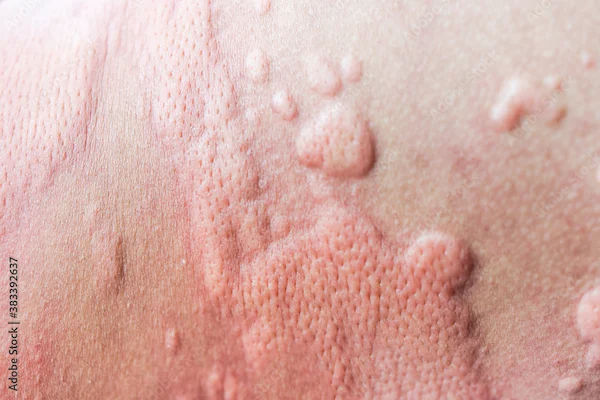Peeling Skin: Exploring Causes And Prevention Methods
Discover the causes of peeling skin, from environmental factors to medical conditions, and explore effective treatments, prevention tips, and when to seek professional care for healthy, resilient skin.

Written by
Last updated on 3rd Jul, 2025
Dermatological ailments such as peeling skin or desquamation are quite common and can occur due to a variety of reasons like environmental conditions, inherited medical conditions, etc. Now, the skin serves as a protective shield against penetrating foreign factors like harmful microorganisms, UV rays, and environmental toxins.
Thus, a compromised barrier due to skin peeling can lead to several complications. As a result, it is crucial to understand the common causes of peeling skin, associated skin conditions, symptoms, treatment options and more.
Common Causes of Peeling Skin
Skin peeling can be a normal manifestation of skin turnover or a sign of a bigger problem. Flaking skin can be the result of several factors, like:
Environmental Factors
Exposure to extreme weather, like severe cold or too much heat, can rob the skin of moisture, prompting it to flake. Another frequent environmental culprit is sunburn. It causes a breakdown of cell structure due to excessive exposure to UV rays, resulting in skin cells being damaged and often causing peeling as the body heals.
Windburn, commonly occurring when the skin is exposed to high winds, also has similar effects, as it strips the skin of its natural oils, resulting in dryness.
Medical Conditions
Diseases like eczema, psoriasis, and dermatitis are commonly associated with peeling skin. These disorders compromise the skin’s natural barrier, leaving it susceptible to drying out and more likely to flake.
Peeling can also be a result of other systemic issues, like vitamin deficiencies or thyroid problems. Vitamin A or C deficiency, for example, harms the skin repair system, further aggravating peeling and dryness.
Allergies and Irritants
Exposure to allergens or irritants can cause skin inflammation and peeling. Some common triggers are certain cosmetics, detergents and plants, such as poison ivy. People with particularly sensitive skin are more likely to have such reactions.
Infections
Localised peeling can be caused by fungal infections, like athlete’s foot, and bacterial infections, like impetigo. Viral infections (such as measles and scarlet fever) can also cause peeling as one of its symptoms. Another cause can be peeling skin syndrome, an extremely uncommon genetic illness that results in persistent shedding of the skin.
Skin Conditions Linked to Peeling
Some of the major skin conditions linked to peeling are:
Eczema
Atopic dermatitis, or eczema, is a long-term condition that results in inflamed, itchy and peeling skin. This condition can develop anywhere on the body, such as on the face, on the hands, or behind the knees and is often distressing.
Psoriasis
It is an autoimmune disorder that speeds up the turnover of skin cells, causing scaling and peeling. The condition commonly appears as thick red patches with silvery scales.
Dermatitis
This involves inflammation of the skin that can occur from an allergic reaction (allergic contact dermatitis) or exposure to irritants (irritant contact dermatitis). Symptoms include redness, swelling and peeling.
Symptoms Associated with Peeling Skin
Peeling skin usually occurs with other symptoms that can provide hints about the possible underlying condition:
Redness and Itching
Inflammatory conditions like eczema and psoriasis typically present with redness and intense itching alongside peeling. This can lead to further irritation if scratched. Persistent itching may also disrupt sleep, affecting the overall quality of life.
Dryness and Cracking
Excess dryness often leads to cracking and peeling of the skin, most commonly in extremities exposed to frequent washing or harsh climate. Cracked skin can be painful and prone to infection. For example, cracked heels in winter can develop fissures which bleed and cause pain.
Formation of Blisters
Fluid-filled blisters may appear before any peeling takes place. This is usually noted with sunburns or infections like impetigo. Toxic epidermal necrolysis, a life-threatening skin condition, is another situation in which blistering and peeling can indicate a severe medical emergency.
Diagnostic Approach to Peeling Skin
A proper diagnosis is the key to finding the cause of peeling skin and the right treatment:
Consult a dermatologist if the peeling doesn’t go away, gets worse or is accompanied by other symptoms, such as fever, pain or severe redness.
Intervening early can help avoid complications. For example, pus or swelling around areas of peeling skin indicates infection and requires immediate attention.
A dermatologist might conduct a physical exam and take the patient’s medical history.
Skin biopsies or allergy tests may be performed in some cases to determine the cause.
Blood tests also may be needed to look for systemic conditions, like autoimmune diseases or nutritional deficiencies.
Treatment Options for Peeling Skin
When it comes to treating peeling skin, healthcare providers focus on healing the root cause:
Topical Treatments
Moisturisers and emollients can help restore the skin’s barrier function, alleviating dryness and peeling. For specific skin conditions, like eczema and psoriasis, medications such as corticosteroid creams may also be prescribed. Furthermore, it is essential to use calamine lotion or antihistamine creams to provide relief from itching.
Systemic Medications
For severe cases, systemic treatments, including oral corticosteroids, immunosuppressants, or biologics, may be required. These are usually administered for autoimmune or chronic conditions. Healthcare providers may also prescribe oral antifungal medicines for widespread fungal infections.
Home Remedies
Applying aloe vera gel or coconut oil or taking oatmeal baths at home can provide relief to irritated skin. But they should aid the strategy, not replace medical treatments.
Preventive Measures for Peeling Skin
The best way to prevent skin from peeling is to practice habits that keep your skin healthy:
Regular skin care (light cleansers, moisturisers, etc.) is a must. Wear sunscreen every day to protect yourself from UV-induced damage. Choose hypoallergenic products that may reduce the potential for irritation, particularly for people with sensitive skin.
Recognising and steering clear of known irritants or allergens can prevent outbreaks of conditions such as eczema or contact dermatitis. For example, people prone to sunburn should minimise sun exposure and wear protective clothing.
Gloves worn during chores protect hands from the adverse effects of harsh chemicals and detergents.
Drinking plenty of water, eating a balanced diet full of vitamins and minerals and reducing stress all contribute to overall skin health.
Omega-3-rich foods, such as salmon and walnuts, promote hydration and elasticity in your skin.
Antioxidants found in colourful fruits and veggies can also help fight free radical damage, keeping the skin supple and resilient.
Complications of Untreated Peeling Skin
Persistent skin peeling, if not properly managed, can result in serious consequences:
Infections
Cracks or peeling open up portals for bacteria and fungi and raise the risk of infections like cellulitis or fungal overgrowth.
Scarring and Hyperpigmentation
Repeated peeling or scratching can compromise the skin’s deeper layers, resulting in scarring or uneven pigmentation, especially in darker skin tones.
When to Seek Medical Help for Peeling Skin?
It is good to seek timely medical attention for particularly severe or persistent symptoms:
Skin peeling that occurs with systemic symptoms, such as fever, chills, or joint pain, can be a sign of a more serious condition, including toxic epidermal necrolysis or lupus. These need immediate medical treatment.
If symptoms do not improve with home care or over-the-counter therapies, a professional evaluation is essential. This helps rule out underlying medical problems, especially for people with a history of chronic skin disorders or autoimmune diseases.
Conclusion
Peeling skin can occur due to several different causes which include environmental factors, medical conditions, and infections. Determining the underlying cause is essential for treatment and prevention. By proactively caring for your skin, you can reduce the frequency and severity of skin peeling. Early diagnosis and treatment can help avoid complications and improve the quality of life.
Consult Top Dermatologist
Consult Top Dermatologist
Dr. Kavitha Killaparthy
Dermatologist
23 Years • MBBS,DIPLOMA(DERMATOLOGY,VENEREOLOGY,LEPROSY)
Hyderabad
JDS Skin & Hair Clinic, Hyderabad
Dr. Mayuri Jain
Dermatologist
11 Years • MBBS, MD Dermatology , Venereology & Leprosy
Delhi
Dr Mayuri Jain Clinic, Delhi

Dr Ekansh Shekhar
Dermatologist
10 Years • MBBS MD
Lucknow
Apollo Clinic Hazratganj, Lucknow
Dr.j Girishma
Dermatologist
6 Years • MBBS MD DERMATOLOGY
Bengaluru
Apollo Medical Center, Marathahalli, Bengaluru

Dr. Satarupa Mondal
Dermatologist
7 Years • MBBS , MD (Dermatology , Venereology & leprosy) , Diplomate (Derm.Vene.Lep)
Kolkata
Dr Satarupa Mondal, Kolkata


